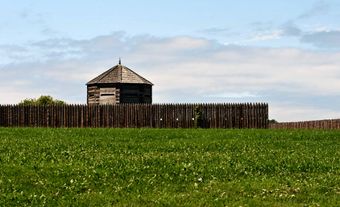Siege of Fort Erie, War of 1812
The siege of Fort Erie was a British blockade of their own fort located at the entrance to the Niagara River opposite Buffalo, New York, which the Americans had captured on 3 July 1814. Although unsuccessful, the siege prevented the last major invading American force during the WAR OF 1812 from penetrating further into UPPER CANADA.
Following the hard-fought BATTLE OF LUNDY'S LANE on 25 July 1814, the Americans retreated to FORT ERIE, where they entrenched and strengthened the stone fortification. The pursuing British commander, Lieutenant-General Gordon DRUMMOND, was forced to first rest his exhausted troops, obtain supplies and find additional men to fill the gaps in his ranks.
It was early August before Drummond appeared at Fort Erie. Feeling that he did not have the manpower for a lengthy siege, he decided to launch a raid against two American supply depots at and near Buffalo. The strategy was based on the idea that if the supplies were lost to the Americans, they might feel compelled to evacuate Fort Erie. The raids failed to achieve their objective, however, and Drummond was forced to plan an attack on what was a strong, well-defended fort.
The Attack on Snake Hill
Drummond first ordered a siege battery to be constructed. A two-day bombardment of the fort from the battery's guns began on 13 August, but the result, as one British officer noted, "was very trifling." Nevertheless, Drummond went ahead with his plans for an assault on the fort, set for 2:00 am on 15 August, conducted by three separate columns at three different points. The first was a position known as Snake Hill. Located slightly over 700 metres south of the fort, this was a large sand mound the Americans had strongly fortified and connected to the fort by a series of earthworks. Once this position was taken, the two other columns were to advance, one attacking the fort itself and the other the earthworks extending north from the fort to nearby LAKE ERIE.
The attack on Snake Hill went badly. Led by Lieutenant-Colonel Victor Fischer, the British advance was detected far sooner than it was anticipated, and quickly came under withering fire from the defenders. In the darkness, this brought on panic, confusion and then retreat. To complicate the situation, Fischer's men had been told to remove the flints from their muskets so no accidental firings would ruin the element of surprise. They were to rely on bayonets only, but there had been virtually no opportunity to use them.
The Attack on the Northern Entrenchments
At 3:00 am, the other two columns had moved forward. The attack on the northern entrenchments also went badly. The commander, Colonel Hercules Scott, was only one of many who were killed by heavy American firepower. The remainder of his column then moved west and merged with the column of Lieutenant-Colonel William Drummond (a younger distant relative of Gordon Drummond), which had already made several unsuccessful attempts to capture the fort's northeast bastion.
It was finally taken in one last desperate try; however, Drummond and his men became trapped when the Americans determinedly blocked the narrow corridor that led to the rest of the fort. During this heavy fighting, William Drummond was killed.
General Drummond's assault on Fort Erie ended when a large supply of ammunition stored under the bastion's wooden platform suddenly blew up, causing a tremendous explosion and a great loss of life. A survivor later described the carnage, writing that hundreds of men "lay roasted, mangled, burned, wounded, black, hideous to view." The British force had suffered some 900 killed, wounded or missing in action in contrast to the Americans, who suffered only 62 casualties. Drummond was dismayed but determined, and continued the siege.
American Counterattack
On 17 September, the Americans made an attempt to break the siege by carrying out a well-planned sortie. Several British batteries were captured and their guns spiked before Lieutenant-General Drummond was able to organize his resistance. The fighting was heavy and losses considerable before the Americans were pushed back. Having lost half his siege guns and with his ranks greatly reduced by casualties and sickness, Drummond lifted the siege on 21 September and withdrew to the north side of Chippawa Creek (Welland River), some 30 km down the Niagara River.
Although the Americans had not been forced out of Fort Erie, they were not able to exploit their position and attempt their long-hoped-for grand sweep across the Niagara Peninsula to Burlington Heights (Hamilton) and on to York (Toronto). Drummond, who was about to be reinforced, blocked their way, and the British Navy regained control of Lake Ontario. On 5 November 1814, the Americans retreated across the Niagara River to Buffalo. Fort Erie, where so much blood had been spilled the preceding few months, was blown up to prevent it being of any use to the British.

 Share on Facebook
Share on Facebook Share on X
Share on X Share by Email
Share by Email Share on Google Classroom
Share on Google Classroom

